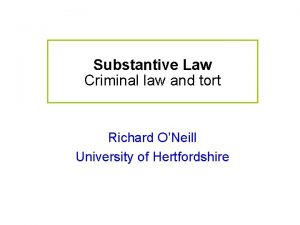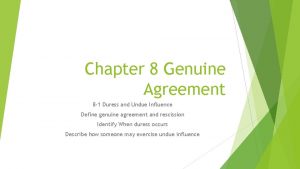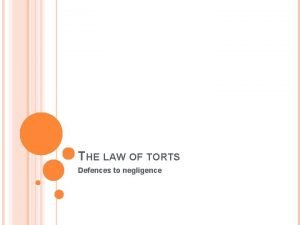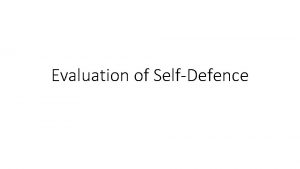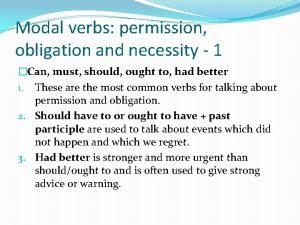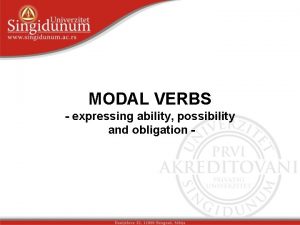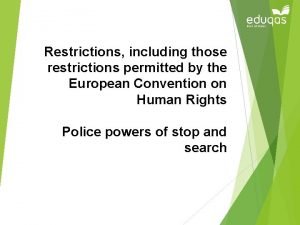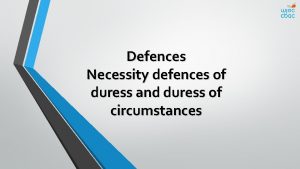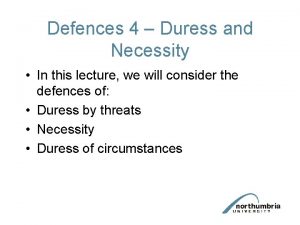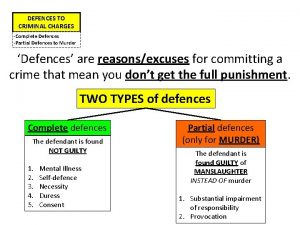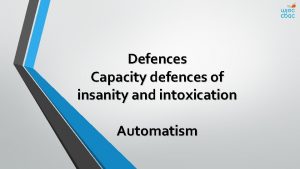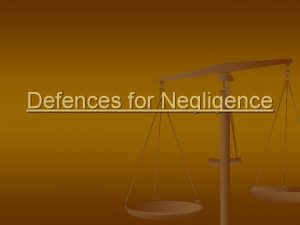Necessity defences of self defence duress and duress

















- Slides: 17

Necessity defences of self defence, duress and duress of circumstances Duress and necessity

Duress • This defence exists where the defendant is put under considerable pressure to commit a crime or face death or serious injury to himself or another for whom he feels responsible – the defendant is faced with a terrible dilemma. • The problem is that the defendant commits the actus reus with the mens rea so the defence takes the circumstances into account.

Duress • Duress can be used as a defence to all crimes except murder, manslaughter and perhaps treason Gotts (1982), Howe (1986), DPP for Northern Ireland v Lynch (1975). • The defence takes two different forms: – Duress by threats • This consists of direct threats to the defendant to commit a crime or face death or serious personal injury to themselves or another. – Duress of circumstances • This consists of external circumstances that the defendant believes constitutes a serious threat. • There are some similarities to necessity here – see later slides for the overlap with necessity.

Duress by threats Courts have to consider the seriousness of the harm that the accused has been threatened with and the criminal behaviour they commit. • Graham (1982) – 2 stage test: – Subjective test – did the defendant feel he had to act the way he did because he reasonably believed he would face death or serious personal injury. – Objective test – would a sober person of reasonable firmness same the defendant • The with threatthe must be ofcharacteristics death or seriousaspersonal injury. respond in the same way as the defendant. • • The cumulative effect of threats can be considered by the courts: – Valderrama-Vega (1985) • Was threatened with disclosure of his homosexuality and financial problems but also had death threats.

Duress by threats • The threat must be unavoidable: – Gill (1963) • Defendant had the opportunity to inform the police between the threat and carrying out the crime so couldn’t use the defence. – R v Hudson and Taylor (1971) • Threat was considered to be imminent as defendants were witnesses in trial where those threatening them were in the gallery despite the fact that there were several police in the court building. – R v Hasan (2005) • This is the current law which takes a stricter approach as in Gill. Here the defendant knew he was involved with a criminal gang so put himself in the way of possible threats.

Duress by threats • The threat must be operative at the time of committing the crime. • R v Hudson and Taylor – the defence was allowed as the threat was still operating when the defendants were giving evidence in the court as they believed it could be carried out immediately. • Abdul-Hussain (1999) the defendants were Shi’ite Muslims who had fled from Iraq to Sudan because of the risk of punishment and execution because of their religion. They feared they would be sent back to Iraq so they hijacked a plane, the plane landed in the Uk. The defendants were charged with hijacking and pleaded the defence of duress. The trial judged ruled that the defence could not be used as they were not in sufficiently close and immediate danger, they were convicted. On appeal the Court of appeal quashed their convictions , they held that the threat need not be immediate, but it had to be imminent in the sense that it was ‘hanging over them’.

Duress by threats • • Who must the threat be made to? – The defendant themselves. – A family member or even close friend: • Martin (1989) – Wife threatened suicide if the defendant didn’t continue to drive whilst disqualified. Self-induced duress: – Defendant’s own actions have led him to be placed under the threat so cannot use the defence. – Hasan (2005)– defendant joined a criminal gang so was unable to use the defence when he was put under threat because he should have realised that could happen.

Duress of circumstances • • This defence was first recognised in the case of Willer (1986) • Defendant’s car was surrounded by a gang of youths who threatened him. He drove along the pavement as his only route of escape but was convicted of reckless driving. The appeal court allowed duress of circumstances. and confirmed in Conway (1988) • Two men ran towards the defendant’s car. The defendant’s passenger had been shot at a few weeks earlier so he considered that the two men were a threat so drove off and was charged with reckless driving. His appeal was successful and duress of circumstances was allowed as a defence.

Duress of circumstances • Martin (1989) – Court stated that the 2 stage test in Graham for duress by threats also applies to duress of circumstances. • Pommell (1995) – Court ruled that the defence was available to all offences except murder, manslaughter and treason. • Cairns (1999)

Problems with duress • The defence is not available for murder but there are situations where it might be necessary and unjust to not allow it. • Hasan has narrowed the circumstances in which the defence can be available which may mean it is not available to those who need it. • A defendant’s low IQ is not considered by the Court following Bowen (1996). • Hudson and Taylor shows that even where the defendant is surrounded by police protection they may not consider this more powerful than the threat.

Necessity • This is a very limited defence as the Courts have generally not been prepared to accept it. • Defendants are placed in a position where they believe they have to commit an offence to prevent a worse evil from happening.

Necessity • The original case where necessity was raised is: Dudley and Stephens (1884) 3 people shipwrecked miles from land; the 2 stronger men killed and ate the cabin boy with them nearly 3 weeks later in order to survive; they were rescued four days later; convicted of murder on return to England; they used necessity as a defence; although it wasn’t allowed, the usual sentence of death was lowered to 6 months imprisonment in recognition that they were faced with a terrible dilemma.

Necessity • Although there is not much move to recognise the defence in criminal cases, there has been more recognition of its availability in civil cases. • Re F (Mental Patient: Sterilisation) (1990).

Necessity • Re A (Conjoined Twins) (2000) – Doctors were faced with a terrible dilemma – if they didn’t separate the twins both would die but if they separated them then one of them would die and the other would possibly live. TASK • Consider what the doctors should do in these circumstances?

Necessity • Re A (Conjoined Twins) (2000) 4 circumstances were developed where necessity would be permissible: 1. Where an act was done only to avoid consequences which could not otherwise be avoided. 2. The consequences would have inflicted inevitable and irreparable evil. 3. No more was done than was reasonably necessary for the purpose. 4. The evil inflicted was not disproportionate to the evil avoided.

Necessity • R v Shayler (2001) – A further criteria for the defence to be available was added to those in Re A in this case: • The evil must be directed towards the defendant or a someone for whom they had responsibility. – The defendant was a member of MI 5 who had disclosed official secrets and argued it was out of necessity to improve efficiency of MI 5 but did not fulfil the criteria as no-one was in imminent danger of death or serious injury.

Necessity • In Southwark London Borough Council v Williams (1971) Lord Denning stated that allowing the defence of necessity would ‘open a door that no man could shut’ and would give an excuse for all types of behaviour. • Although there are questions about this defence, the Law Commission in the Draft Criminal Code states: – “We are not prepared to suggest that necessity should in every case be a justification; we are equally unprepared to suggest that necessity should in no case be a defence. ”
 General defences in tort
General defences in tort Dawlish warren sea defences
Dawlish warren sea defences Duress occurs when
Duress occurs when What are capacity defences
What are capacity defences Bipolar analysis of coastal defences
Bipolar analysis of coastal defences Holbeck hotel scarborough
Holbeck hotel scarborough Under duress
Under duress Defences to negligence
Defences to negligence Ideal self explanation
Ideal self explanation Evaluation of self defence
Evaluation of self defence Self defence for disabled
Self defence for disabled Obligation, necessity, or permission
Obligation, necessity, or permission Necessity advisability and expectations
Necessity advisability and expectations Expressing necessity and ability
Expressing necessity and ability Advokate police
Advokate police Explain the necessity of irrigation
Explain the necessity of irrigation Necessity of fuse
Necessity of fuse Tipe-tipe wirausahawan menurut ir. ciputra adalah
Tipe-tipe wirausahawan menurut ir. ciputra adalah
